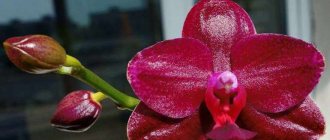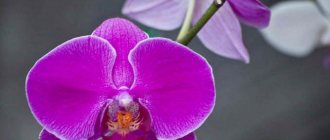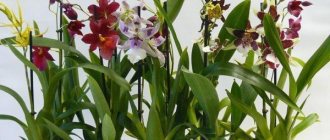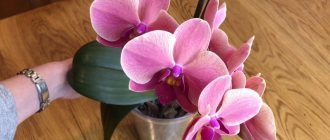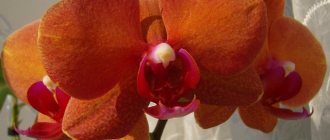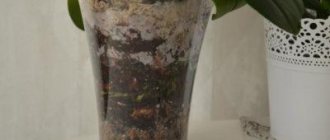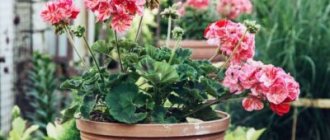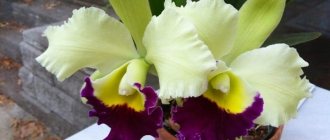Orchids captivate everyone from the first meeting. The Sogo phalaenopsis genus fascinates with its luxury. But the plant requires special conditions for care. Have you acquired this beauty? We'll show you how to take care of it properly. We will also reveal the features of the subspecies, which cannot be neglected if you are planning to become a breeder. At the end, we will talk about the diseases of this wonderful plant. After all, it is better to prevent them than to treat them.
History of origin
Phalaenopsis Sogo (Phalaenopsis Sogo from lat.) is a hybrid species of orchids, crossed on the basis of 14 plants of the same family. Breeding experiments lasted from 1962 to 2003.
This is interesting: the ancestors of the flower mostly grew in Australia. Some of them are from Southeast Asia and the Philippines.
In the 19th century, the owner of the botanical garden, who also had the title of professor in the field of plant growing, Karl Ludwig Blume, traveled around the Malay Archipelago. And it was there that I first saw a wonderful creature. Its exotic buds, when opened, resembled bright butterflies. This is how the first phalaenopsis was discovered. On later dates, other cases of people meeting these beautiful representatives of the flora were recorded. Gradually, other subspecies of the Orchid family were revealed to the world, from which the Sogo genus was developed. The path to its creation lies entirely on the shoulders of scientists.
Description of appearance
Miniature grex belongs to epiphytes: in natural habitats it grows on stones, trees, in forests and gorges with high humidity.
Main characteristics of the variety:
- The height does not have strict limits, but in some subspecies it can reach 80 cm. Most individuals are small in stature, but there are also real giants. With regard to the latter, it is impossible to do without additional support to support the trunk. Peduncles with a large number of buds hang.
- Mature phalaenopsis has 6 leaves. Dwarf groups have small plates - up to 10 cm in length and 5 cm in width. The shape is oblong, typical of Orchids. The structure is dense and a little rough.
- Arrow dimensions vary depending on the variety.
- Most of the representatives of this species have flowers up to 8 cm in diameter, and dwarf ones - 5 cm. The color ranges from white to purple or deep purple.
Description of the variety
In the wild, Phalaenopsis orchids live in humid, warm forests. They originated in Asia and number about 70 species. According to the description, the structure of orchids consists of tuberidia or pseudobulbs, but Phalaenopsis lacks all of this.
This is a monopodial orchid that grows slowly in height. Orchids are propagated using bulbs. How many years an orchid lives depends on the amount of vital energy of a flower, but it decreases when flowering and development of children are stimulated. During the breeding season of Phalaenopsis, fertilizers and fertilizing must be used.
Phalaenopsis is not inferior in the frequency of keeping at home to the Dendrobium Nobile hybrid.
Description of leaves and tree
Phalaenopsis is an orchid with a special rhythm of development, growth and smell. To determine the age of a plant, count the number of large leaves.
An adult tree has the shape of a rosette with two rows of leaves arranged.
The house Phalaenopsis orchid has a short stem that grows upward. And the aerial root system is well developed. Their thickness is up to 7 mm in diameter. The roots are covered with a layer of special absorbent tissue - velamen. They have a silvery-green color.
Phalaenopsis at home reaches 50-70 cm. In a healthy plant, the rosette consists of 4-6 leaves. Up to 2 new leaves appear during the year. They are dense and colored a rich dark green. They have an oblong-oval shape. They are located alternately, and a peduncle grows between them.
Description of colors
Peduncles, depending on the type, are long (up to 80 cm) and short (about 20 cm). They have curved or straight shapes. Flowers also have different diameters from 2 to 15 cm. They are collected in racemose inflorescences and resemble the shape of a butterfly or star. The growth period varies from 2 months to six months.
The Phalaenopsis orchid has a pleasant and unobtrusive aroma.
The house Phalaenopsis orchid blooms twice a year - in spring and autumn. The flowering period depends on the interaction of the general condition of the plant and the characteristics of its care.
Types of varieties
The phalaenopsis flower is distinguished by the size of the leaves, the length of the peduncle and the color. Characteristics of varieties:
| Variety name | Description |
| Amabilis | Leaves are from 30 to 50 cm, green, up to 12 cm in diameter. The petals are white and the flower lip is yellow or peach. Amabilis bloom from early autumn to March. |
| Schilleriana | Flowers come in purple or single color. Blooms in winter. |
| Stuart (Stuartiana) | Peduncles are long - 80 cm in length. The petals are purebred with red spots at the base. They bloom from mid-winter to March. |
| Amsterdam Jordan | Raspberry petals in a dark dot. The lip has a burgundy tint. |
| Horse (Equestris) | Pleasant aroma and large leaves up to 13 cm. Flowers purple or lilac. |
| Natasha (Natasha Aiko) | It has 3 pairs of leaves and reaches 12 cm in height. Pink or green with spots all over the flower. |
Variegated Phalaenopsis variegated includes varieties: Filipinensis and Lindeni. The species Stone Rose, Little Zebra, Sumatra, Ping, Rossini and Sacramento are famous for their crimson shades, and the small-flowered variety Phoenix, Venus, Violet, Tonka and Pulhra are famous for their rich scent.
The Phalaenopsis orchid has many varieties.
Yellow petals: Solid Gold, Nina Queen, Yara, Mango and Maya with red splashes. The ampelous saffron milk cap is colored orange, like Surfsong and Novelty.
Varieties with white petals:
- Leopard Prince;
- York;
- Pinglong;
- Ikaria;
- Leonardo;
- Cambridge;
- Phalaenopsis super Beautyful.
- Tetraspis and Gemeng - white petals with red dots.
Purple color is characteristic of the varieties Phantom and Extra, Multi, Martin, Angel, Nyezhdnik, Cherry and Jewel. The Manna species has green leaves with purple dots.
The Mandala variety has creamy caramel petals with a Leopard lip. Sesame is distinguished by a tiger pink and white pattern on its petals. Interesting flowering species: Panda, Elegant, Deborah, Aloha, Leo, Ravello, Zion and Tabor.
Facts about the orchid say that among its varieties there is a Royal species. The plants are blue in color and look like the sky. But in natural living conditions there is no such color.
What is the difference from other types of orchids?
Not only are the exotic flowers of this group full of colors, but the leaves also have interesting patterns and combinations. Individuals with plain plates are rare. This is the key feature of Sogo - it belongs to variegated plants, which are characterized by uneven color.
The most common leaf blades are those with white, red and purple stripes. The lines can be very thin, barely noticeable, or wide, behind which greenery appears. The placement also fluctuates: strictly in the middle, along the edges, on one side.
This unusualness, combined with variegated buds, most attracts attention to the phalaenopsis of this group. Due to the long peduncle, the ovaries are arranged in a cascade, which looks very impressive. Depending on the subspecies and age, the arrows can reach 50 cm in length.
This is interesting: Sogo is often confused with the Big Lip group, but the latter is distinguished by its original lip, although the sepals are full of bright patterns.
Description of the orchid
A white orchid in your home symbolizes pure love due to its color, which traditionally signifies innocence and purity of thoughts. Her entire appearance exudes beauty and elegance. You will definitely please your loved ones with this flower by presenting them with a white orchid as a gift.
If you want to buy yourself a white orchid, but choose a plant from discounted flowers that do not have flowers, focus on the color of the leaves. In white varieties it will be a bright green light shade. Colored orchids have darker leaves with a purple tinge underneath.
At the time of sale, white phalaenopsis usually has 4-6 oval green leaves collected in a basal rosette and a long peduncle (straight or curved) with a racemose inflorescence consisting of snow-white flowers. The lip can be yellow, crimson or white, covered with colored specks. White varieties of orchids are odorless. Only a small part of phalaenopsis can boast of aroma.
In addition to pure white varieties, there are hybrids with a colored border on the petals or having inclusions of crimson or purple. Such spotted varieties are called “Dalmatians” and “watercolors” in the description. They look very fresh and elegant, enlivening any room with their presence.
Sogo orchid varieties, photo
Like every independent genus of the Orchid family, this one also produces “babies”. Groups of plants in this category have a lot of common features, but at the same time there are differences, which will be discussed below.
Relax
A variety that really surprises even experienced amateur plant growers. Flowers with “waxy” petals of a rich beet color have a scent similar to lilies, but not so strong. In the Russian Federation, this plant is supplied from Asia, but it is extremely difficult to find it on the open market. To acquire one, you will have to try and use the help of specialized groups or Internet sites that distribute phalaenopsis.
Sogo Relax is an unpretentious orchid and its care requirements are not much different from its counterparts grown in Holland. Any person who has positive experience in growing epiphytes will be able to cope without any problems.
This is interesting: this subspecies tends to grow arrows to extend the flowering period. Sometimes the process occurs for 7-8 months in a row.
Lawrence
It has red, non-fading dense petals with yellow edges. Sometimes the light tone is very narrow, and sometimes it takes up a significant part. The spots closer to the lip look more like stripes, and then disperse into dots. Some cultivators produce fragrant specimens, but this difference is not typical for all, as it strongly depends on the breeding conditions.
The arrow is branching, which causes a lush crown during flowering. The scarlet lip sometimes has a white or purple edge. The sepals are wide and the bud has a regular shape.
Sogo Lawrence is an orchid with blurry light spots on the leaf blades. This looks more than original and for the most part is characteristic only of this variety.
Yukidan
An elongated and slender plant with white or pink petals. The diameter of the open buds ranges from 12 to 14 cm. The lip is figured and resembles a brooch. The leaf blades are bright green, wide and dense, decorated with a longitudinal light vein in the middle.
The Sogo Yukidan orchid, as seen in the photo, looks like an elegant Asian figurine. The arrows are full of bright “moths” and bend to the ground under their weight. The petals are rounded and wide, shimmering in good light, like sugar.
This is interesting: the subvariety belongs to Doritenopsis - flowers obtained by crossing Orchids such as Doritis and Phalaenopsis.
Vivien
This plant has two features that significantly distinguish it from its other counterparts: the color of the leaves and petals. They are unique in their kind. Pink, lilac or purple flowers have veins that are a couple of shades darker and shimmer with iridescence. The dark green plates are bordered by wide, uneven light stripes. The sepals are full, and the petal is darker than the overall color.
Pony
Bright yellow flowers with large burgundy spots. The lip is crimson with a white border. The smell is pleasant and unobtrusive. Branched arrow. The green leaf blades sometimes have subtle light spots, like the Lawrence variety. As you can see in the photo, the rich open buds really look like exotic butterflies, standing out against the background of any plants.
Gotris
A dwarf beauty with an arrow no longer than 25 cm. The flowers are also not impressive in size, but they delight with bright colors and a delicate aroma. The yellow petals from the center of the bud have a red or pink tone that gradually dissipates.
Lip with a white tip and a small “nose”. The ovaries on the arrow are staggered, and it does not bend much under their weight after opening. In general, the plant resembles the Lawrence variety, but has significant differences in size and color type.
Rose
Phalaenopsis of this subvariety resembles Relax in appearance, only the tone of the petals is darker. “Waxy” buds are distinguished by long-term flowering, and against their background the lip practically does not stand out, only the edge is white. In some individuals, the sepals have a border and look as if the main light background, and the upper one consists of nearby large spots.
This is interesting: this plant belongs to the novelti variety - taking into account the conditions necessary for its healthy life, it blooms almost all the time.
Grape
The voluminous and slightly elongated petals of this variety are glossy and dense to the touch. The sepals are more shaped like the green plates of orchids than the usual buds. The lip stands out a little against the general deep lilac background with an orange color. Some subspecies come with a light thin border or a palette closer to cherry shades.
The younger the plant, the fewer ovaries there will be on the arrow. The leaf blades are wide and without “decorations”. In general, the variety is not large in size.
Bianca
A delicate creature of pale green or white color with pink and sometimes orange streaks. Lip with the same spot. The leaf blades have a shape characteristic of phalaenopsis and a healthy grassy color. The plant is dwarf and the arrow is short, without branches. Holds about 10 buds in a chaotic arrangement. Their disclosure is sequential.
Shito
Yellow background with white or pink spots closer to the center of the bud. The lip is the same color as the secondary tone. This variety has a pronounced smell, and the petals seem to be covered with wax. The height of the plant reaches a maximum of 40 cm. The arrow is short and replete with a small number of flowers.
Jessica
The embodiment of snow-white grace with a lilac core. The lip is large and more saturated in color than the sepals. The diameter of the buds and the size of the adult depends on age. Even when young, the epiphyte sometimes produces two arrows. Pleases with bright colors all year round.
This is interesting: the price depends on the type and prestige of the outlet, but ranges on average from 1 to 2.5 thousand rubles.
Indoor orchid paphiopedilum (lady's slipper): photos, names and descriptions of plant species
Paphiopedilum appletonianum (Gower) Rolfe - Appleton's Paphiopedilum (subgenus Paphiopedilum, section Barbata).
The variegated slipper comes from Thailand, Laos, Vietnam, Cambodia and the island. Hainan (China). It is found in the undergrowth among decomposed plant remains as a terrestrial plant at an altitude of 600-700 m above sea level. m. Pubescent greenish peduncle, 1-2 flowers, up to 50 cm long.
The flowers of this lady's slipper appear as greenish-purple calyxes. Sepals with green and purple stripes, petals with calloused brown spots, staminode with two distinct notches at the ends.
Flowering specimens can be found from February to June, some in bloom from October to December.
Paphiopedilum argus (Rchb. f.) Stein - Paphiopedilum Argus (subgenus Paphiopedilum, section Barbata).
A very rare shoe with o. Luzon (Philippines). It grows only on the eastern or western slopes of mountains, rising to a height of 800-2500 m above sea level. m., as a rule, in a thick layer of moss at the base of tree trunks or in leaf litter and humus among bamboo thickets.
As shown in the photo, this paphiopedilum orchid has spotted, bluish-green leaves with purple undersides:
A purple, pubescent single-flowered peduncle up to 45 cm long, erect, developing a single greenish-purple flower with a white striped dorsal sepal and spotted lateral petals. Blooms from January to April.
Paphiopedilum barbatum (Lindl.) Pfitz. — bearded paphiopedilum (subgenus Paphiopedilum, section Barbata).
Homeland: Malay Peninsula. It is found in mountain forests at an altitude of 200-1300 m above sea level. m., lithophyte.
The leaves are variegated, the peduncle is 1-2-flowered. The flowers are purple-brownish, 10 cm in diameter. Along the edges of the lateral petals there are numerous dark bristles and dark calloused warts.
When describing this lady's slipper, it is especially worth highlighting the lip of the flower - it is purple in front and greenish-brown in back. In nature, plants bloom twice a year.
Paphiopedilum callosum (Rehb.f.) Stein - Paphiopedilum callosum (subgenus Paphiopedilum, section Barbata).
Variegated slipper from the foothills of Thailand, Laos, Cambodia and Vietnam. This type of paphiopedilum grows on low rocks at an altitude of 300-1300 m above sea level. m. in substrates of fallen rotted leaves, sand and mosses, in moderate shade.
A pubescent, erect 1-flowered peduncle up to 45 cm long. The dorsal sepal has longitudinal stripes, the lateral petals are drooping down, crescent-shaped and slightly deflected back, with dark warts along the upper edge.
Variable appearance. Blooms in autumn and early spring.
Paphiopedilum concolor (Lindl.) Pfitz. — Paphiopedilum unicolor (subgenus Brachypetalum).
Grows in Burma, Thailand, Vietnam, Laos, Cambodia and China (Yunnan Province). Lithophyte or terrestrial plant, rises to a height of up to 1000 m above sea level. m. A small orchid with spotted leaves, covered with numerous purple spots on the underside.
Peduncle 1-3 flowered. The name “monochrome” is given to this lady’s slipper for its monochromatic color: the flowers of the plant are white or cream, petals with small chestnut-purple dots are rarely found. The lip is elongated, its outer edge is curved inward.
Staminode with a large yellow spot in the middle. It blooms throughout the year, with the main peak of flowering occurring in the summer months - from May to September.
Paphiopedilum delenatii Guill. — Paphiopedilum Delenata (subgenus Brachypetalum, section Parvisepalum).
Homeland - northern Vietnam and China (Yunnan). It is found at low altitudes in valleys or at the foot of calcareous mountains on rocks and rocks.
The leaves are variegated, the peduncle is erect, 1-2-flowered. The petals and sepals are pink and velvety. The lip is swollen, with the anterior edge curved inward, and is often more brightly colored. Staminode with two bright yellow spots in the center, divided transversely by red-purple longitudinal stripes.
With good care, this lady's slipper orchid blooms in spring or early summer.
Paphiopedilum fairrieanum (Lindl.) Stein - Paphiopedilum Fairie (subgenus Paphiopedilum, section Paphiopedilum).
Homeland - Sikkim, Bhutan, northeast India (Assam). It is found in river valleys along the banks and on chalk stones in diffuse light conditions under a canopy of tall grasses and low trees. It rises to a height of 1400-2200 m above sea level. m.
The leaves are pale green, sometimes with purple spots on the undersides. The peduncle is erect, 1-2-flowered. The flowers are greenish-white with numerous purple-violet stripes. The lip is olive with purple veins.
The main flowering period for this lady's slipper orchid at home is autumn.
Paphiopedilum glaueophyllum JJ Smith - Paphiopedilum sisolieta (subgenus Paphiopedilum section Cochlopetalum).
Lithophyte is native to Sumatra and Java. It grows on volcanic slopes, at low altitudes in areas with abundant regular moisture throughout the year. Peduncles are lodging, develop from 10 to 18 months, on each of them about 20 flowers open in turn. The dorsal sepal is glossy, light green.
As you can see in the photo, this slipper orchid has creamy white side petals with pinkish tips, covered with purple spots:
The lip is lavender-pink, yellowish towards the upper edge. Peduncles appear in spring and summer.
Paphiopedilum godefroyae (Godefr. - Leb.) Stein - Paphiopedilum madame Godefroy (iodrode Brachypetalum).
Homeland: Vietnam, Burma, Thailand. It is found at low altitudes, on steep limestone cliffs.
Variegated slipper with a short 1-2-flowered erect peduncle. The flowers are pubescent, snow-white or yellowish with numerous purple spots. Staminode with a yellow vertical stripe in the center.
Lady's slipper plant of this species blooms in summer, from May to September.
Paphiopedilum haynaldianum (Rchb.f.) Stein - Paphiopedilum haynaldianum (subgenus Paphiopedilum, section Pardalopetalum).
Homeland: Luzon and Negros Islands (Philippines). It is found on rocks and trees or in humus-filled rock cracks at altitudes up to 1400 m above sea level. m. A large green-leaved plant with a lodging pubescent peduncle 50-75 cm long, which develops 4-6 yellowish-green flowers with a diameter of 7.5-16.0 cm.
When describing the lady's slipper plant of this species, it is especially worth noting its elongated drooping petals, which bear large chestnut spots; the khaki-colored lip has dark green veins.
It blooms from February to May, although flowering specimens can be found throughout the year, with the exception of June.
Paphiopedilum helenae Aver. — Paphiopedilum Helena (subgenus Paphiopedilum, section Paphiopedilum).
Homeland - northern Vietnam and southern China. Green-leaved humus epiphyte, found in mountainous areas at an altitude of no more than 850-900 m above sea level. m. among plant remains in rock cracks, on north-facing slopes of river gorges or on vertical rocky slopes, sometimes at the base of the trunks of small trees or shrubs.
Dwarf clones with green narrow leaves 4-12 cm long. A single flower with a diameter of 5-7 cm, its overall color is yellow-brown. The lip is smooth, brownish-orange, 2-3 cm long, 1.5-2.0 cm wide.
The main flowering occurs in the autumn months, but individual specimens continue to develop flower stalks until mid-winter.
Look what Elena's lady's slipper orchid looks like in these photos:
Paphiopedilum hirsutissimum (Lindl. ex Hook.) Stein - Paphiopedilum most hairy (subgenus Paphiopedilum, section Paphiopedilum).
Epiphytic or lithophytic green-leaved slipper from India (Assam), Thailand, Laos, Burma, where it rises into the mountains to a height of 3000-4000 m above sea level. m.
The peduncle is single-flowered, erect, up to 25 cm long. An interesting property of the flower of this lady’s slipper is the gradual corrugation of the upper edge of the side petals, which immediately after blooming look even, but after a day they become finely folded.
Flowering occurs in the spring months and lasts from March to May.
Paphiopedilum insigne (Wall, ex Lindl.) Pfitz. — Paphiopedilum is remarkable (subgenus Paphiopedilum, section Paphiopedilum).
Homeland - tropical Asia. Variable appearance. The leaves are green, narrow. The peduncle is erect, 1-2-flowered, up to 30 cm long.
The flowers are apple-green or greenish-yellow, with a spotted broad-oval sepal bearing a wide white border along the upper edge, brownish lateral petals and a yellowish-green lip of a brown tint.
The flowering of this homemade lady's slipper begins in September-October and continues until February of the following year.
Paphiopedilum malipoense Chen & Tsi - Paphiopedilum malipoense (subgenus Parvisepalum).
It is found in the shade of semi-deciduous mountain forests in northern Vietnam and China (Yunnan) at an altitude of 1300-1600 m above sea level. m., where it grows in the shade on chalk rock outcrops. Plants settle in faults and cracks of vertical rocks, preferring eastern slopes. The leaves are spotted, wide, purple below, slightly wavy.
The peduncle is erect, 1-2-flowered, 40-60 cm long. The flowers are 12 cm in diameter, apple green.
Pay attention to the photo - this lady's slipper orchid has a swollen lip, with the leading edge bent inward:
Staminode with dark spot below. It blooms in spring, the flowers develop very slowly and last about 2 months.
Paphiopedilum primulinum M. Wood & Taylor - Paphiopedilum pale yellow (subgenus Cochlopetalum).
Lithophytic or terrestrial plant from the north of Sumatra, rises to 500 m above sea level. m. The leaves are bright green, without purple dots. The peduncle is lodging, multi-flowered, 50-70 cm long.
The flowers are yellow or greenish in color, smaller than other representatives of the subgenus Cochlopetalum. The flowers open alternately, leaving the plant in bloom for about a year.
With good care of the slipper orchid at home, flower stalks of this species appear in spring and summer.
Paphiopedilum spicerianum (Rehb.f. ex Masters & T. Moore) Pfitz. — Paphiopedilum Madame Spicer (subgenus Paphiopedilum, section Paphiopedilum).
The green slipper is native to northeast India (Assam) and northwest Burma. Butt epiphyte at the base of tree trunks or lithophyte on the vertical walls of gorges. It is found at an altitude of 300-1300 m above sea level. m. Peduncle erect, 1-2-flowered, up to 25 cm long.
As shown in the photo, this lady's slipper has greenish-white flowers with a funnel-shaped dorsal sepal, short frilled petals and a brownish lip:
The staminode has a pink spot with a yellow dot in the center. Blooms from October to December.
Paphiopedilum suhhakulii Shoser & Senghas - Paphiopedilum Sukhakula (subgenus Paphiopedilum, section Barbata).
The variegated slipper is native to Thailand. Grows at an altitude of 1000 m above sea level. m. on clay soils, found along river banks in moderate light conditions.
The peduncle is erect, up to 12 cm long, bears a rather large flower with unusual wide green petals, completely dotted with dark purple spots and dots, with a small pointed striped-white dorsal sepal and a medium-sized lip, purple-brown at the top and pale green at the bottom.
The lady's slipper houseplant of this species blooms twice a year - from February to April and from August to December.
Paphiopedilum venustum (Wall. Ex Sims) Pfitz. — Paphiopedilum charming (subgenus Paphiopedilum, section Barbata)
Homeland - Assam, Bangladesh, Eastern Himalayas, Myanmar, Nepal and China (Yunnan Province) (1000-1500 m above sea level). Grows as a terrestrial plant in the bases of cliffs, dense undergrowth, bamboo thickets, and river canyons.
A terrestrial plant with mottled purple-green leaves. Inflorescences are erect, 1-2-flowered. The flower is 9 cm in diameter, with wide greenish-purple netalae dotted with large dark purple spots and a greenish-pink lip covered with a network of purple veins.
It blooms twice a year - from January to April and from June to December.
Paphiopedilum villosum (Lindl.) Stein - Paphiopedilum pilosa (subgenus Paphiopedilum, section Paphiopedilum)
Green leaf slipper from Indochina. It grows as an epiphyte, lithophyte or terrestrial plant, rising to a height of 1100-2000 m above sea level. m. Strongly hairy erect peduncle, 1-2-flowered.
The flower is yellow-brown, with widened tips of the lateral petals directed forward. The staminode is yellow with a green dot in the middle.
Blooms from autumn to spring.
In these photos you can see lady's slipper orchids, the description of which is given above:
The final section of the article presents photos and descriptions of hybrid species of the lady's slipper flower.
Bloom
The factor due to which beautifully flowering epiphytes are in great demand among plant growers is their amazing buds of a wide variety of colors and color combinations.
When and how?
This wonderful action occurs at any time of the year and is very abundant. Placement of flowers on the arrow: cascade, checkerboard, garland. A distinctive feature of this variety of phalaenopsis is that there is no dormant period.
Before and after care: features
Before the appearance of the Sogo peduncle, a strict temperature regime is needed - +22 °C...+25 °C during the day. At night, a slight difference is allowed - +18 °C...+20 °C. Orchids love light, but in its soft forms. Direct sunlight is destructive for delicate beauties. In winter, you will need additional lighting using a special lamp, but for no more than two hours.
Advice: after flowering, the epiphyte should be removed to a cool place, but without sharp contrast. A slight decrease in temperature stimulates the rapid release of the arrow in the future. Watering during this period is reduced.
What to do if there are no buds
The main cause of this problem is improper watering. A certain period of time must pass between procedures so that the substrate dries out. Moreover, it differs in duration: in summer - from 3 to 4 days, and in winter - 1-2 weeks.
Also, don’t get carried away with fertilizers. Excessive feeding only slows down flowering, causing the appearance of new leaves rather than buds.
Step-by-step care instructions
It is known that hybrid plants adapt more easily to indoor conditions, and Sogo is no exception. It’s just that her needs are a little different from most members of the family.
Important: all epiphytes of the genus cannot tolerate stuffiness. The room should be ventilated frequently, but without cold drafts.
Selecting a location
As mentioned earlier, orchids are afraid of open sun. Experienced collectors of these beautiful plants advise placing epiphytes on northern windowsills, but with additional lighting.
Preparing the soil and pot
When choosing a container, you should give preference to a transparent plastic product with large drainage holes. If there are none, but you like the pot, you can always make them yourself using a hot knife.
We recommend forming small holes in the side walls - excellent ventilation and simplifying the watering process by immersing the pot in water. The size is needed to be small, since growth goes upward, and not to the side, as in representatives with pseudobulbs from other genera.
The filler can be purchased at the store or mixed yourself.
Soil mixture:
- The drainage system is foam or expanded clay at the very bottom. Everything is disinfected.
- Charcoal - small pieces of leftover wood are placed between the roots. It is better to do this with your hands rather than in bulk.
- Moss - sphagnum retains moisture and even with irrigation type of irrigation distributes it everywhere. This material is part of the natural environment of epiphytes of the Orchid family.
- Pine bark - small elements (thoroughly washed and cleaned) are mixed with coal or placed on top, but loosely.
Temperature
Phalaenopsis are thermophilic, but do not tolerate heat well. During the day, the mercury column should not fall below +20 °C. Sudden jumps are also not welcome. This does not depend on the time of year, since Sogo does not need a rest period. Thus, it will bloom regularly and delight you with a healthy appearance.
Important: are you going to transport a plant, but it’s clearly colder outside than at home? A few days before this, you need to gradually change the location of the Sogo pot, placing it in an environment more similar to the street.
Humidity
A lot of liquid in the air is not required. It is enough to follow the usual regime, acceptable for humans - 50-60%. It is worth knowing that drying is more popular for orchids than flooding. If the summer turns out to be too hot, it is enough to spray the leaves once a day.
Lighting
In spring and summer, windows should be shaded. Of course, if they are from the south side. In winter, to extend the light period, it is recommended to use phytolamps, but for no more than two hours.
Watering
Compared to southern window sills, when located near northern windows, the moisture content of the soil mixture is rare. It is important to monitor the rhizome, because by its appearance it is easy to determine the condition of the orchid. If a gray-brown color appears, it means it needs water.
The buds should not be irrigated, otherwise unsightly spots will form. The leaves are sprayed, but it is worth considering that the roots also receive moisture. In the autumn-winter period, 1-2 times a week is enough, and in the heat - once. All these manipulations should be performed in the first half of the day, so that during the rest of the day the epiphyte absorbs the maximum and the excess evaporates.
Important: if overwatered, the plant may rot and begin to hurt. In most cases, the matter ends in death.
Top dressing
Performed simultaneously with watering. We recommend adding any rooting agent for better development of the rhizome. Apply special mixtures no more than once a month. They are not very necessary, but they will not harm the young animals. In any case, you should alternate between clean water and water mixed with fertilizers. After the buds appear, fertilizing is not advisable.
Transfer
After purchasing a young orchid, place the pot in quarantine for 2 weeks. During this time she will have time to adapt. Then it can be transplanted.
Subsequence:
- We use the transshipment method without destroying the old earthen ball. The substrate must be dry. Squeeze the pot on both sides. Carefully remove the plant with all its contents.
- If there was drainage in the old container, it is better to leave it there and put a fresh one in the new place. The embankment should occupy no more than 1/4 of the total space.
- Place the earthen ball in a new container that is larger than the previous one.
- Cover with suitable substrate. Do not tamp or push the flower! If part of it remains uncovered, it's okay. This is an epiphyte.
- Place the pot in a bowl of settled water at room temperature. Let stand for 15 minutes and remove. All excess should drain off.
Important: the leaf axils should not be wetted.
This method is only relevant for healthy individuals. Sometimes “moving” becomes forced due to illness, and the rhizome should be cleared of the soil mixture and further treated with a special preparation. Cleaning with a sterile instrument is also required in the presence of rotten (flaccid) roots.
Agricultural technology for caring for the lady's slipper orchid
According to agricultural technology for home care, Paphiopedilum orchids can be divided into 3 ecological groups - terrestrial, lithophytic and (rarely) zniphytic. They all prefer potted culture.
According to the requirements for temperature and light during care, paphiopedilums are divided into three groups. The first group includes variegated species that live at low altitudes above sea level, are kept in a warm temperature regime (winter night temperature 16-18 ° C) and prefer diffuse lighting.
These are shoes from subgenera:
Brachypetalum
Parvisepalum
Paphiopedilum (section Barbata).
The second group consists of green-leaved, usually mountainous, 1-2-flowered species that require moderate and cold conditions (winter night temperature 10-14 °C) and intense lighting.
This includes species from the section Paphiopedilum . The third group includes green-leaved slippers with multi-flowered peduncles, which require warm conditions and bright lighting.
These are views from three sections:
Cochlopetalum
Coryope dilum
Pardalopetalum
Most slippers from the subgenus Braehypetalum stand apart in cultivation, preferring not just warm conditions, but differences in day and night temperatures, moderate watering and a calcium-enriched substrate.
When caring for lady's slippers, the correct soil is very important. Soil mixtures that include leaf and turf soil, peat and river sand are suitable for growing paphiopedilums from the Paphiopedilum section.
The soil mixture is prepared in the same way as for most indoor plants, mixing all the components taken in certain proportions.
In accordance with the correct agricultural techniques for caring for paphiopedilums at home, good drainage from broken clay shards must be placed at the bottom of the clay pot. The plant is placed in the center of the pot, the roots are carefully straightened and the substrate is poured on top.
It should not be compacted; instead, the pot is shaken a little during planting, tapping the bottom on the transplanting table. The soil mixture should cover all the roots and the very base of the shoots, while the shoots themselves should remain on the surface.
Epiphytic substrates prepared on the basis of crushed bark with various additives from charcoal, polystyrene foam and sphagnum moss are suitable for growing all other groups of paphiopedilums.
Examples of soil mixtures for slippers from the subgenus Paphiopedilum:
- Leaf soil (1 part), black lowland peat (2 parts), coarse river sand (1 part);
- Finely chopped fern rhizomes (1 part), crushed sphagnum moss (1 part), leaf soil (1 part), coarse river sand (1 part);
- Crushed pine bark (2 parts), sphagnum moss (2 parts), river sand (I part).
Sometimes, as a substrate for caring for lady's slippers at home, seedling-graded bark (with pieces with a diameter of 0.6-0.8 cm) is used, planting the plants in the same way as in soil mixtures. It is advisable to cover the surface of the substrate with live sphagnum moss; this will protect young roots from premature growth cessation. If plants are kept in conditions of insufficient moisture, a thin layer of sphagnum can be wrapped around the bases of young shoots.
A special place is occupied by paphiopedilum orchids from the subgenus Brachypetalum , the substrates of which are supplemented with additives containing easily washed out calcium, for example, dolomite chips. In this case, chalk chips or crushed stone may be present in the pot in the form of a drainage layer, and eggshells or crushed mollusk shells may be poured on top of the substrate. If dolomite flour is added, then it is added at the rate of 1 g per liter of substrate and mixed thoroughly.
When caring for these orchids of the Paphiopedilum genus, they can also be kept on a rocky substrate by sweeping away coarse crushed expanded clay, dolomite chips and coarse river sand in a ratio of 2:1:1. Such a mineral substrate assumes an almost hydroponic culture, so regular fertilizing is required, which is applied with every second watering.
Calcium is also added to the substrate for paphiopedilums from the Brachypetalum section in the form of dolomite flour, chalk chips, eggshells, etc.
When caring for lady's slipper orchids at home, they should not be watered often, but generously. The amount of irrigation water per plant should be several times the volume of the pot. No wonder they say: “Shoes cannot be destroyed by abundant watering, but they can be destroyed by too frequent watering.”
When watering, the substrate should be well wetted, and then the plant need not be watered for 2-3 days. For good growth when caring for orchids, most slippers only need one heavy watering with fertilizing and one heavy watering with clean water per week to rinse the substrate and roots from salinity.
Here you can watch a video of caring for indoor lady's slippers:
The short rhizome of many types of paphiopedilum with a small number of adventitious buds capable of development is most often the reason for the inability of plants to survive unfavorable conditions for a long time. Paphiopedilums do not produce “babies” either on the shoots, or on the peduncles, or on the roots, so the hope for renewal lies only in the viability of these rhizome buds.
The following are photos and descriptions of lady's slipper plants of various types:
How to propagate?
In greenhouses this is done with the help of seeds and “babies”. The last method is the only one possible for increasing the number of epiphytes at home.
Step-by-step description of the procedure:
- Choose an adult with a healthy rhizome as the mother. The peduncle should still be fresh, but without buds.
- Using a sterile instrument, cut the “dormant” bud. If there are any on the stem, you can use them too.
- Sprinkle the wound with crushed coal or cinnamon. Otherwise it may rot.
- The baby will develop on the maternal trunk for another 1-2 months. He needs to grow 2-3 leaves and the same number of roots.
- Only after this can they be finally separated and placed for cultivation.
Growing
It is recommended to place the pot with the plant in the northwestern part of the apartment or in the eastern part with shading. Placement on a windowsill or balcony is suitable for this. The orchid does not like changing its place of residence, so the gardener does not move it from one place to another in order to grow a healthy flowerpot.
Small pots are used to grow plants. There must be holes at the bottom for drainage, and their height is equal to the width of the neck. The most common option is plastic pots; they do not allow the root system to dry out. With the help of plastic flowerpots you can clearly see:
- growth of the root system;
- moisture consumption on the substrate;
- when the soil is completely dry.
They also use clay flowerpots, preheated and moistened. Orchids are also grown in a greenhouse, hydrogel or hydroponically, like indoor plants. Hydroponics is when flowers grow in water, expanded clay in glass containers.
Phalaenopsis hybrid is a monopodial orchid. The only growing point appears at the top of the shoot. Therefore, they reproduce by children, seeds or cuttings; they rarely use tree division.
Pollination
Phalaenopsis is characterized by only cross-pollination. Autogamy in a flower is practically impossible. If several plants that bloom at the same time are grown at home, then hybrid pollination is carried out.
It is recommended to pollinate several plants at the same time. This increases the chance of getting seeds. If even one specimen is successfully pollinated, untouched flowers will not bloom for a long time.
It is better to pollinate several plants at the same time
Flower seeds ripen in 6 to 8 months.
Growing seeds at home: At the end of the flower there is a column, which is carefully torn off with tweezers. Pollinia are removed from it and placed in another flower. To secure the pollinia, they are placed on sticky walls. If the bud is pollinated successfully, the plant's axil will close. After which it dries and the stem swells. When the flower turns brown, begin sowing.
Reproduction by children
Propagated by children 2 months after the end of flowering (late February or mid-June).
Choose an adult plant more than 2 years old, with 4 large leaves. For the process you will need:
- crushed activated carbon;
- blade or knife;
- soil made of pine bark, sphagnum and perlite;
- container with drainage holes.
To begin with, cut off the shoots from the stem of the peduncle with a sharp object and allow time to dry. We treat the cut areas with activated carbon. Afterwards, the shoot is planted in a container with a substrate and watered along the edge. Keep the sprout at a temperature of 30°C during the day and 15°C in the evening.
If a baby sprout does not appear on the peduncle, then measures are taken to stimulate the plants. To awaken the buds, carefully remove the scales without injuring the dormant buds. After this, a little hormonal paste is applied to them or damp moss is placed on top of the buds and covered with polyethylene. The contents of the hormonal mixture include:
- 10 g kinetin;
- 1 ml water;
- 1 g lanolin.
The mixture should turn white. Children are also treated with hormonal drugs:
- "Heteroauxin";
- "Kornevin";
- "Epin."
Propagation by cuttings
When propagating, the roots should be handled carefully. Only healthy Phalaenopsis orchids can be successfully propagated. The method of propagation by cuttings is more complex. It is done after the plant has flowered.
For cuttings, use side shoots 10-15 cm in length. They need to be separated, and the top shoot is cut off with a sharp sterile object. The sections are treated with charcoal. Afterwards the sprout is placed in a container with a substrate.
Moist sphagnum and a small amount of moss are chosen as soil. Temperature 25-28°C.
Diseases and pests
Sogo is most prone to parasite attacks and illnesses caused by excess moisture. And each case requires an individual approach to treatment.
Mealybug
The insect infects the upper part of the epiphyte. The larvae must be removed mechanically - with a sponge soaked in a soapy solution, and then rinsed in the shower. In this case, the soil is covered with a film, otherwise active substances may get there. Then the plant is treated with an insecticide. After 40 minutes, wipe off excess drug with a cotton swab. The procedure must be repeated after a week.
Spider mite
The appearance of this pest can be easily determined by the web that very quickly forms on the crown of the phalaenopsis. By feeding on the sap of a plant, the parasite destroys it, which means that measures to combat it should be taken immediately. For treatment, use the Fitoverma solution according to the instructions on the package. The procedure is performed 3 times at intervals of 7 days.
Rot
Appears when air stagnates or is over-humidified. The flower is cleaned of all rotten areas and transplanted into new soil. Watering stops for a while. Before planting, the roots are treated with Fundazol, and the cuts are treated with charcoal or cinnamon.
Important: all used instruments and old pots are disinfected with a copper sulfate solution after treatment procedures.
Prevention of various problems
- Infections are most often transmitted through watering. Therefore, it is recommended to install pots with phalaenopsis on grates, above pallets, so that they do not stand in water.
- Pots and tools should be treated before replanting or cleaning and after the procedure.
- Observe the conditions necessary for the plant and properly care for it.
“Once you are hooked on orchids, it is impossible to give them up” - a quote from Orchid Fever. And the author of this work is right. After all, when you can’t spend a day without looking at your beautiful Sogo, the epiphytes have already conquered you. So give them the much needed attention so that they can delight with their delightful and unique flowers.
